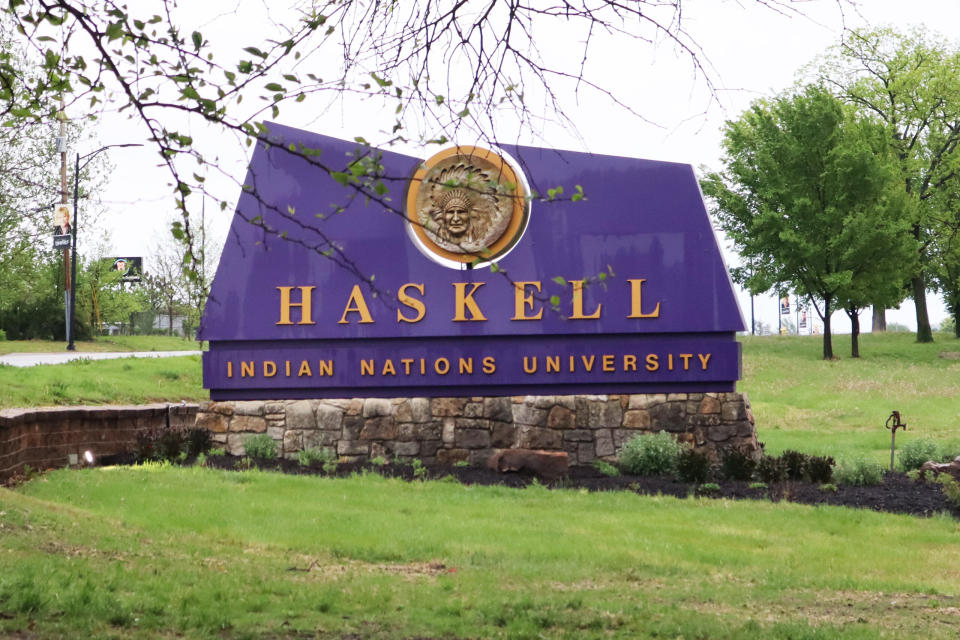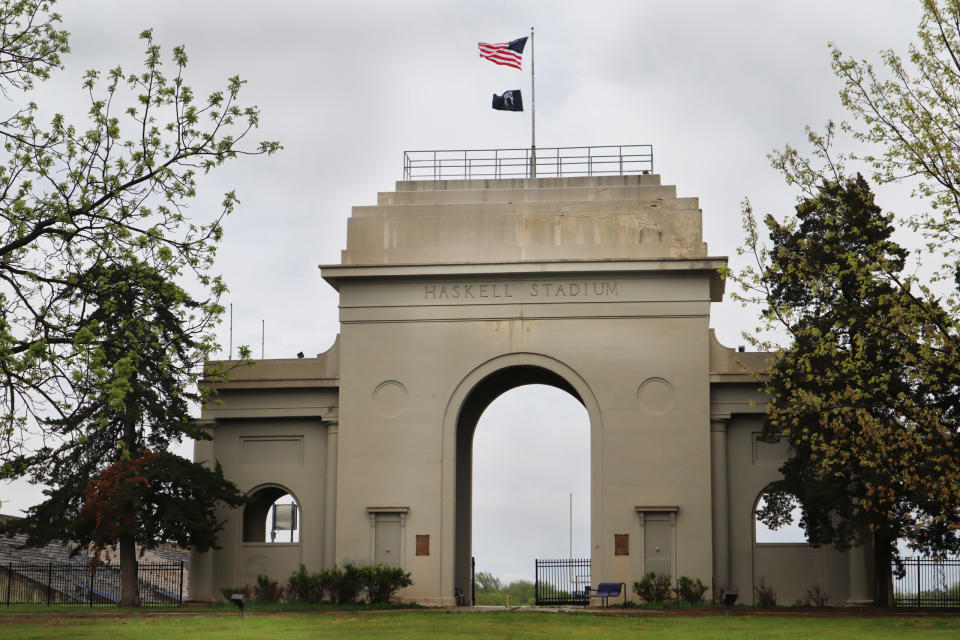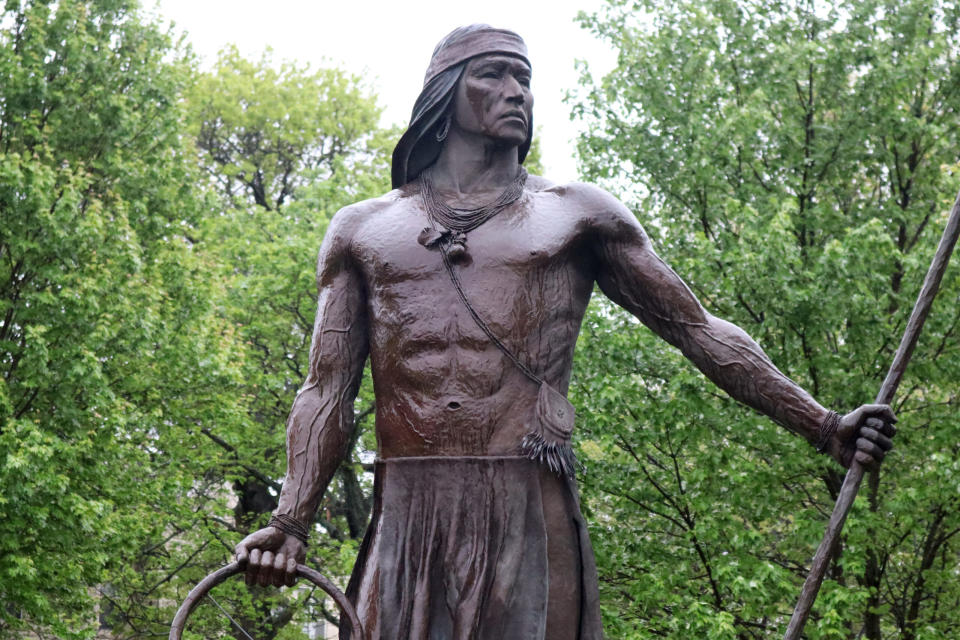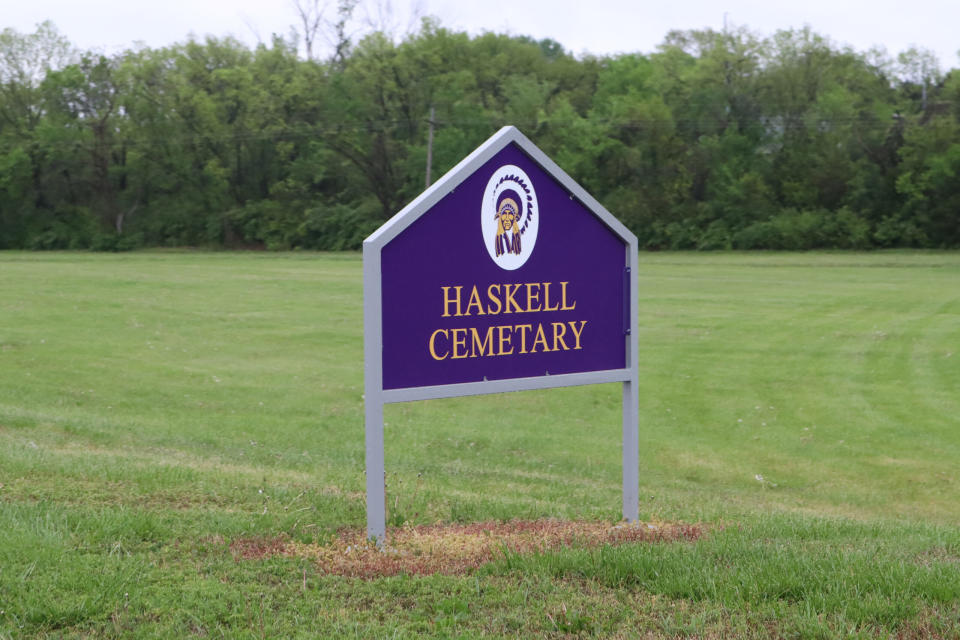Report reveals ‘dysfunction’ at Haskell University. We owe the past — and future — much more.
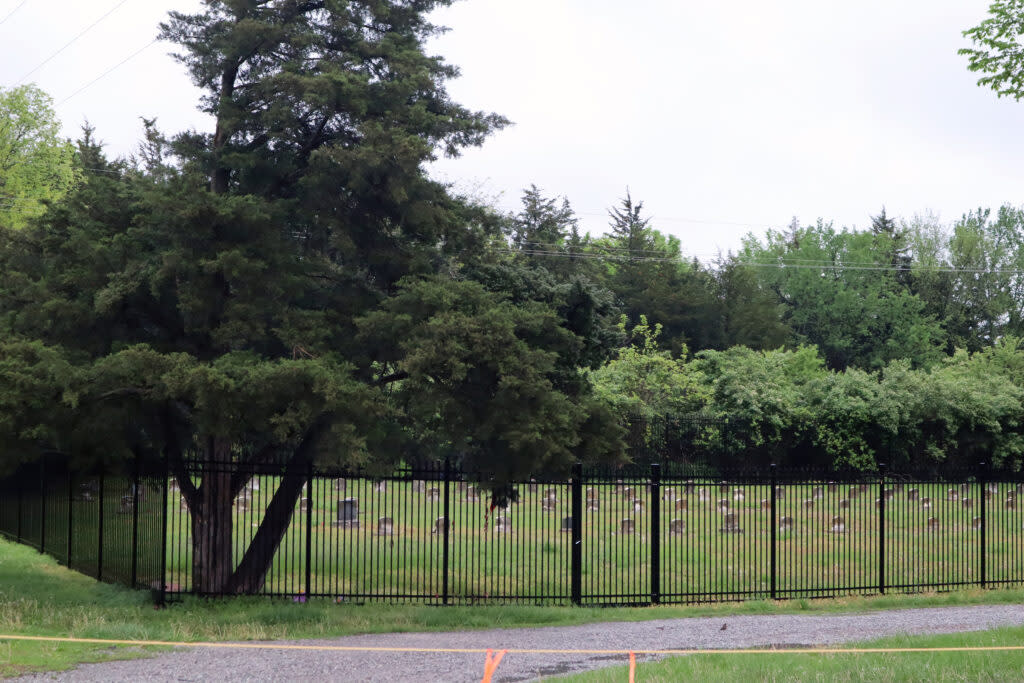
The cemetery at Haskell Indian Nations University in Lawrence holds the remains of 103 children who died during the early years of the institution's history, which began in 1884 as a federal boarding school for Native American children. The cemetery was fenced in 2018 to prevent vandalism. (Max McCoy/Kansas Reflector)
LAWRENCE — There are 103 Native American children buried in the cemetery on the southeast corner of the Haskell Indian Nations University campus. Not all the graves are marked, but those that are carry the child’s name, their tribe and their lifespans.
The first burial was that of Harry White Wolf, a child of the Cheyenne nation, who died in 1884. That was the year Haskell — originally named the U.S. Indian Industrial Training School — was opened as one of three non-reservation boarding schools established by Congress.
I’m not sure if Harry White Wolf’s family thought of him as “Harry,” but I doubt it. Nearly all of the children buried here have anglicized names. Maggie Big Fire, Cheyenne, 1869-1887. Fred Buffalo, Ponca, 1869-1886. Charles Panther, Osage, 1867-1885. May Mohaja, Kaw, 1880-1887.
The giving of white names to Native American children was part of the process by which the federal boarding schools aimed to make them conform to white society. Whatever these children were called, their names may now be lost to the wind.
The responsibility we owe as a nation to the children buried at Haskell and at similar Indian boarding school sites across the country is to remember the hardships, the abuse and sometimes the ultimate price they paid for forced assimilation.
Haskell, a boarding school known for its harsh conditions and stern discipline, is now the Haskell Indian Nations University. It is a federal facility and the only university of its kind. Operated by the Bureau of Indian Education, it is the Harvard of Native American education — and, according to a recently released investigative report, a campus that fails to act on reports of sexual abuse, lacks institutional control to prevent theft and other abuses, and is unresponsive to student complaints.
“The question is what the hell is going on at BIE,” Jeff Ruch, a director at the nonprofit Public Employees for Environmental Responsibility, told me. “From what I can tell, they’ve invested far more energy in trying to hide the report than acting on it.”
Ruch said PEER was involved in prising the report out of federal hands because that’s what they do — seeking, through the Freedom of Information Act, information in the public interest, especially when a public employee or whistleblower contacts them. In the case of the Haskell report, it was Clay Mayes, the school’s former cross country coach, who contacted them for help. Mayes, a member of the Cherokee and Chickasaw tribes, was fired in April 2022. He felt he’d been the victim of retaliation for reporting what he believed was theft and sexual misconduct at the university.
“We’re a service organization,” Ruch said. “We often liken ourselves to a shelter for battered staff.”
The entrance to Haskell Indian Nations University at Lawrence, Kansas, in April 2024. A recently released federal investigative report has described the campus as “dysfunctional.” (Max McCoy/Kansas Reflector)
Part of the Department of the Interior, the BIE is responsible for 183 elementary and secondary schools on 64 reservations in 23 states, according to the bureau website. The BIE operates only two post-secondary institutions, Haskell and the Southwestern Indian Polytechnic Institute at Albuquerque.
The report, compiled by a three-member investigative board appointed by the BIE, amounts to a “scathing assessment” of Haskell’s response to numerous reports by students of sexual assault by other students and inappropriate touching by a staff member, Ruch said. In addition to taking minimal actions on sexual assault complaints, he said, student services employees did not believe it was their responsibility to notify law enforcement when students reported a sexual assault. There was also no follow-up to check on the welfare of students after the reports, placing the safety of students at risk.
“The (investigative) Board finds HINU to be severely dysfunctional and severely lacking processes and procedures,” the report said. “In addition, the board … supports the notion that Mayes (the cross country coach) was subject to a level of targeted bullying and unfounded allegations made against him.”
The report, which is administrative and does not represent a criminal investigation, was submitted to the BIE’s human resources officer in November 2022 and finalized in January 2023. Since then, the report had been denied to those seeking answers, including four students who were interviewed by investigators and told they’d be informed of the result.
Although a redacted copy of the report is now available, for more than a year the students, other interested parties, and the public were denied the findings of the investigatory board.
Haskell president Frank Arpan — the university’s eighth president in six years — declined a request for an interview. Arpan, who is a member of the Yankton Sioux nation, was named president in May 2023.
An assistant to Arpan directed my inquiries to a spokesperson for the BIE. The layers of alphabet-soup bureaucracy involved — HINU, BIE, DOI — is enough to discourage requests for information. It also hampers public understanding because of the complexity in seeking answers.
Nobody — not a single official at Haskell, BIE, or any other agency I asked over the course of three days — was willing to be quoted or even named in connection with the Haskell report.
Was anybody disciplined for the dysfunctional campus? Were any students harmed by the lack of response to complaints of sexual misconduct? Was someone held accountable for the bullying and apparently improper firing of the cross country coach?
“Students allege they reported serious grievances to Mona Gonzales, Interim HINU President, Tamara Pfeiffer, BIE Director, Tony Dearman, and Assistant Secretary Bryan Newland, expressing their grievances,” the report said.
Investigators found no evidence than any official acknowledged the student correspondence, according to the report.
The stadium entrance at Haskell Indian Nations University stands against a cloudy sky in April 2024. (Max McCoy/Kansas Reflector)
The BIE spokeswoman I spoke with, who asked not to be named, said she was unable to answer my questions about accountability at the school. She also said could not give me the name of a specific contact who could comment on behalf of the Interior Department or Secretary Deb Haaland, who in 2021 became the first Native American to serve as a cabinet secretary.
She gave me a general email address for media contacts. My emailed request for comment from Haaland or anyone in the Interior Department went unanswered.
The BIE spokeswoman later give me a 160-word statement, on the condition it be attributed only to the bureau. The statement concluded with: “Haskell Indian Nations University is working on implementing several policy and procedure recommendations, including reviewing existing policies and procedures and creating new policies where needed to address employee and student sexual harassment and bullying; athletic equipment and facility use and management; student athlete eligibility; and student alcohol and drug use.”
The statement also claimed the BIE “is committed to the safety and well-being” of students, faculty and staff at the institutions under its direction: “Several allegations were initially made to Haskell officials in the Fall of 2021. The BIE promptly responded to the concerns raised by initiating administrative investigations and, after following required laws, policies and regulations, finalized the investigations by January 2023.”
Redacted investigative reports have been posted on the Bureau of Indian Affairs website, the statement said. What the statement didn’t say is that the report calling the campus “dysfunctional” would never have been released if a savvy third-party — PEER — hadn’t filed suit in a D.C. court to get it.
Ruchs is buying none of BIE’s posturing. The bureau buried the report, hoping it would never see the light of day. The larger issue is one of accountability, he said, and in the Haskell case accountability is like the old joke about the weather.
Everybody talks about it, but nobody does anything.
“This was in the upper reaches of the agency,” Ruchs said. “It makes you think the problems extend far beyond Haskell university. For Secretary Haaland, who’s in charge of all this, one would think she would want to kick ass and take names.”
Last September, those four students — Ilijah Coleman, Jarek Chimoni, Tierra Thomas and Brian Masayeseva — filed FOIA requests for the BIE report of the investigation for which they all were interviewed. The investigation wasn’t limited to the firing of Mayes, but included a spectrum of allegations about the university, including nepotism, sexual assaults, workplace harassment and bullying, fraud, waste, and abuse.
PEER first requested the report in April 2023. It subsequently filed a federal FOIA suit for release of the document. Last November, the bureau submitted a 528-page report to PEER, but it wasn’t the one the students had sought. Instead, it was a different report into the Mayes firing conducted by another agency. Ruch said he believed the switched report was not an error, but done deliberately to hide the report into corruption and misconduct by Haskell leadership.
The long sought-after report from the BIE investigative team, though redacted, was released last week. The four students, the fired coach, and the public finally had some answers.
The report has already resulted in demands for accountability. Jerry Moran, a Republican who is the senior U.S. senator from Kansas, on Thursday called for an overhaul of the Bureau of Indian Affairs and said he wanted answers from Haaland by May 8.
This isn’t the first time scandal has rocked the school.
In 1989, Haskell president Gerald Gipp was accused of nepotism, grade-changing, mismanagement and attempting to give more than 300 acres of the campus to the city of Lawrence. Gipp, a member of the Standing Rock Sioux nation, was the first Native American appointed to head the school. But some faculty accused Gipp of being a “sellout” and showing grade favoritism to his daughter, according to reporting by the Kansas City Star. He was removed from office pending an investigation. A Bureau of Indian Affairs inquiry cleared Gipp and resulted in his reinstatement as president, but he was chided for his handling of things. Gipp requested, and received, a reassignment to duties in the bureau’s Washington office.
In 2018, a report from Interior’s Office of Inspector General concluded former Haskell president Venida Chenault has mishandled sexual misconduct complaints, according to the Associated Press. In 2021, president Ronald Graham was fired for stifling the free speech rights of students and faculty by interfering with the campus newspaper, The Indian Leader, including instructing student journalists not to contact the police or other agencies for information.
A bronze statue by Craig Goseyun depicts an Apache hoop and pole game player. The statue, erected in 1997, is on the campus at Haskell Indian Nations University at Lawrence. (Max McCoy/Kansas Reflector)
Still, the evolution that Haskell has undergone in 140 years is nothing short of remarkable.
The school was the Haskell Institute from 1890 to1970; Haskell Indian Junior College from 1970 to 1993; and in 1993 became Haskell Indian Nations University. Today, it has an enrollment of about 700. It is open only to members of federally recognized Native American tribes, according to the Bureau of Indian Education, and tuition is free. Students pay a few hundred dollars in fees each year.
During Haskell’s first year, back in 1884, there were 22 students and three faculty members. Although the school was not restricted by age or tribe, the first children sent here tended to be younger and the courses were elementary in nature.
The school’s stone buildings were unheated and many of the children suffered from a particularly cold and wet fall. Harry White Wolf, the first child buried in the campus cemetery, according to a walking tour brochure of Haskell, died of pneumonia. Harry was only six months old and probably came with his family in a wagon train of Cheyenne and Arapaho families from agencies in what is now Oklahoma.
Conditions worsened because of inadequate funding fires, and crop failures, according to the Haskell website. Forty-nine deaths were recorded in the school’s first five years.
But unhealthy living conditions was just one of the challenges the students faced. Many did not speak English or the languages of the children from other tribes, and they weren’t used to the school diet. They were the target of a system designed to break their tribal identities and assimilate them into white society.
In 1886, Haskell instituted a strict form of discipline by establishing a “cadet battalion organization of five companies” to break up tribal associations and force reliance on English to communicate, according to a 2022 federal report on the history of the Native American boarding school system. This was a concept characterized by Capt. R.H. Pratt, founder and superintendent of the Carlisle boarding school in Pennsylvania, as “kill the Indian in him, and save the man.”
In 1890, the school was renamed for Dudley C. Haskell, a congressman from Lawrence and chair of the Committee on Indian Affairs. But the emphasis on discipline continued.
In April 1909, the Osage City Free Press reported that two teenaged Haskell students were captured by the city marshal. “The two boys had been attending Haskell college at Lawrence and had ran away from the institution,” the Free Press reported. “The boys had walked from Lawrence to Osage City. They were placed in the city jail until Sunday, when they were sent back to Lawrence.”
Haskell is no longer a prison masquerading as a boarding school. It provides tuition at a cost that is unheard of in American higher education today. Native men and women are free to come, or not, as they like, and pursue their careers and perhaps their dreams. Those who have attended Haskell include U.S. Rep. Sharice Davids, D-Kansas, a member of the Ho-Chunk tribe.
Haskell literally contains nations.
A sign at the entrance to the lane leading to the cemetery holding the remains of 103 Native American children. The children died in the early years of the institution’s history, when it was a federal boarding school. (Max McCoy/Kansas Reflector)
The cemetery, with its 103 graves tucked into a corner of the Haskell campus, remains a poignant reminder of the past. It is a sounding of the depth of our national soul and a grim testament to the federal government’s mistreatment of Native American children in the name of conformity.
Taking somebody’s name is one way to steal their identity. Refusing to respond to legitimate concerns about sexual misconduct, bullying and corruption is another form of abuse that should not be tolerated.
The release of the BIE’s investigative report on Haskell is a start. But more is needed, including a criminal investigation into the abuses uncovered by the report, reinstatement of the fired cross country coach, and sanctions against administrators and faculty members who may have dismissed sexual assault complaints.
Finally, Haaland — who is squarely at the top of the alphabet soup of agencies responsible for Haskell — must personally address the dysfunction at the university. And she should come to campus in Lawrence to do so.
Max McCoy is an award-winning author and journalist. Through its opinion section, the Kansas Reflector works to amplify the voices of people who are affected by public policies or excluded from public debate. Find information, including how to submit your own commentary, here.
The post Report reveals ‘dysfunction’ at Haskell University. We owe the past — and future — much more. appeared first on Kansas Reflector.
